#Monolithe Noir
Text
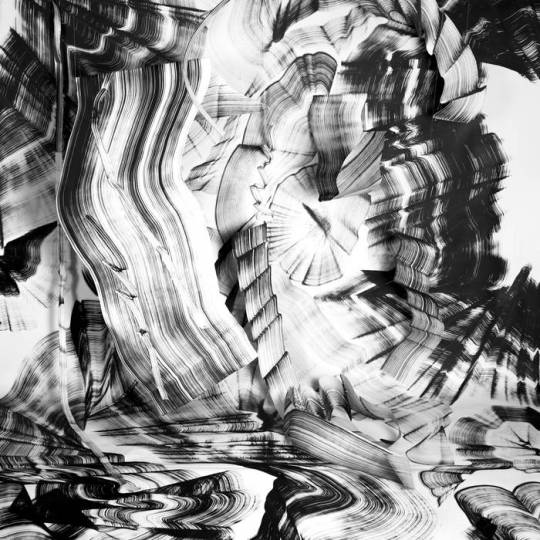
Nina De Angelis
Cover for Rin (Album by Monolithe Noir)
1 note
·
View note
Text
Monolithe Noir — Rin (Capitane)

Rin by Monolithe Noir
The music of Monolithe Noir is mostly built around glowering synth textures and motorik drums, ably balancing atmospheric density with rhythmic heft. Rin, the band’s third album, is shot through with energy and menace, investing equal attention to resonant instrumental timbre and the effective tension that can be built up via the deft handling of repetition. Take album opener and standout “Balafenn,” for example. Each element feels meticulously crafted in the mix, each layer of instrumental detail progressively building into a wall of sound, topped off with a skyscraping synth melody that steals the show.
The best points of comparison here are probably Can, Beak and Portishead’s Third. Most of the atmosphere and melody comes from the instrumental presence, while the vocals on “Finvus,” “Brik,” “Barra Bouge” and “Landmaerck” add another sinister, droning element to the mix. “Brik” foregrounds a bristling tangle of electrified textures while the drums tumble and stomp, before a thick bass steamrollers through the middle. “Barra Bouge” features ominous spoken word over a stark funereal march, finally erupting into a cacophonous crescendo of buzzing synths, screaming distortion and nightmarish violin. “Landmaerck” feels like a battle for supremacy between drums and synth, the rhythmic aspect of each attempting to lord it over the other. Eventually the hi-hats win and the synths dissolve into layered drones. Then, suddenly, the song bursts forth into a massive groove that’s a dead ringer for Silver Apples’ “Oscillations.”
On “La Source,” synth takes the lead while the backing is a more conventional assemblage of bass, acoustic guitar, and shuffling drums. Sparse centerpiece “Morse” is little more than an eerie, dappled lattice of rhythmic woodwind textures, but provides a welcome break from the predominantly drum-driven tracks. Oddly, the title track feels like the album’s least essential moment, lost in a purgatory of musical parts that circle each other uneasily, reaching no evolution or resolution. For the most part, though, Rin offers plenty of head-nodding, immersive krautrock jams.
Tim Clarke
#monolithe noir#rin#capitane#tim clarke#albumreview#dusted magazine#electronic music#krautrock#brussels
1 note
·
View note
Text
VIDEO: Monolithe Noir – Askre
VIDEO: Monolithe Noir – Askre
Das französische Trio Monolithe Noir bringt seine stürmischen Fieberträume im Stil von Battles/Shellac zurück in den Vordergrund, bevor das Album am 26.08.2022 veröffentlicht werden soll.
Conceived as a kind of homage to the British Australian band’s Serpent’s Egg digital medieval inclination, Askre means “chest” in Breton. It also means conscience. The song was built on a theme played on a…

View On WordPress
0 notes
Text
The hypersexual Jezebel, the doting mammy, the angry Black woman according to Montreal filmmaker Ayana O'Shun, these three tropes dominate representations of Black women in popular media -- and negatively affect Black women in the real world.
Her new documentary, 'Le Mythe de la Femme Noire' (Myth of the Black Woman), breaks down these stereotypes and their histories and shows women embracing their own unique identities.
"[Black] women are not a monolithic block. They are diverse, and they are all different," O'Shun told CTV News Saturday, the day after her film hit Quebec theatres.
"It's possible to break free from them and create your own identity. You don't have to [conform] to these stereotypes."
The film features interviews with 21 different Black women from various backgrounds, from artists like Quebec rapper Sarahmée to human rights leaders like Myrlande Pierre.
"I wanted for an audience to be inspired and empowered by these women who are Black, because [for] me growing up in Montreal, these models were not shown to me in regular media," O'Shun explained. [...]
Continue Reading.
Tagging: @politicsofcanada
94 notes
·
View notes
Text
Character Profile - Dark CPUs




Creations of Kurome Ankokuboshi, the Dark CPU's resemble that of the four main CPU's; Neptune, Noire, Blanc and Vert.
Key characteristics indicate that their eye colours are a darker shade of the originals, and instead of Share Energy they thrive off of Negative Energy.
They resemble the CPUs iconically, except for Neptune, who has visible purple glowing cracks under her eye. Kurome spent more time corrupting that version of Neptune more due to their nature.
However, one key difference is that they do not transform into their Heart personalities. They become the original model of Dark CPU:

Spawning at over 30 meters tall, the original Dark CPU's are giant monoliths of Negative Energy. In their first showcase, the Dark CPU's were responsible for completely obliterating their respective nations; in the Zero Dimension only Planeptune was the last nation standing, the rest of the world was an empty void.
It takes a lot of Share Energy to successfully contain one and weaken it enough to be damaged, otherwise Dark CPU's are nearly untouchable.
#divine lore#the mun behind the divinity#divine character profile#guest muse: dark purple#guest muse: dark black#guest muse: dark white#guest muse: dark green
2 notes
·
View notes
Text
Métal Hurlant (1981)

Réalisé par Gerald Potterton, Canada, 90 min
Métal Hurlant est une parodie de science-fiction robotique, déjantée et Rock n' Roll.
Une orbe verte luisante, incarne le mal ultime et terrorise une jeune fille avec une anthologie d’histoires bizarres et fantastiques de dark fantasy, d’érotisme et d’horreur.
L''un des premiers films d'animation pour adultes à être distribué dans les circuits du Cinéma de masse, la violence graphique, une nudité et une sexualité explicites, dans une ambiance de Space Opéra Métal et Punk, en ont fait un objet culte et intemporel malgré la spécificité de ses références. Il a ouvert la voie à d'autres films d'animation, on pense notamment à "Akira" sorti quelques années plus tard en 88.
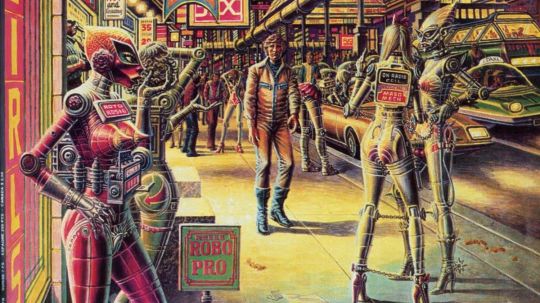
Métal Hurlant était un célèbre magazine de science-fiction, prémices du style Cyber et steampunk et autres délires post nucléaires. Le film éponyme est une adaptation plus ou moins libre de la bande dessinée française originale, créée en 1974. où l'on pouvait trouver les styles de dessin de certains des plus grands artistes de bandes dessinées de l'époque, tels que Moebius, Philippe Druillet et Enki Bilal. Le film a également incorporé de la musique rock et métal de groupes tels que Black Sabbath, Blue Öyster Cult et Devo, ce qui a contribué à établir le genre de la bande dessinée métal. . Quatre ans plus tard, le réalisateur Gerald Potterton et les écrivains Daniel Goldberg et Len Blum s’associent pour en faire une adaptation cinématographique.
Ce film canadien met en vedette les talents d’une distribution au combien canadienne, d'éminents acteurs, dont le producteur Ivan Reitman et les interprètes John Candy, Joe Flaherty, Eugene Levy et Hard Ramus. A l’âge d’or des films d’anthologie comique, quatre ans après Kentucky Fried Movie et quelques années avant Amazon Women on the Moon.
Le film compte neuf segments, sans compter son épilogue. Ils sont marqués par une animation grossière, même aux normes de 1981, et une nudité surprenante. Il y avait aussi beaucoup de musique, bien que tout ne corresponde pas nécessairement dans le genre musical titulaire; en plus de la chanson-titre de Sammy Hagar, le film présente des styles musicaux de Blue Oyster Cult, Journey, Don Felder, Nazareth, et Cheap Trick.

La ligne dans tout cela est Loc-Nar, une petite sphère extraterrestre qui refait surface sous différentes formes tout au long du film, et sur des siècles d’histoire humaine, un peu comme les monolithes en 2001 : A Space Odyssey.
Le film « Harry Canyon », un hommage à Taxi Driver et à la tradition du film noir, met en vedette un chauffeur de taxi et une femme fatale improbable. Un autre était le segment « Den », mettant en vedette le personnage créé par le célèbre dessinateur de bandes dessinées Richard Corben.
« Captain Sternn » (exprimé par Eugene Levy), qui joue dans un drame de salle d’audience. Accusé d’une litanie de crimes, y compris « 12 chefs de meurtre au premier degré, 14 chefs de vol à main armée de biens de la Fédération, 22 chefs de piraterie dans l’espace, 18 chefs de fraude, 37 chefs de viol — et une infraction en mouvement ». Il plaide non coupable, ayant soudoyé un témoin, bien que le témoin soit dépassé par une version humaine musclée de Loc-Nar.
Ensuite, il y a le fameux segment « So Beautiful & So Dangerous », qui culmine avec un robot (exprimé par John Candy) ayant des relations sexuelles avec une femme humaine, bien qu’à l’écran jusqu’à ce qu’ils argumentent avec humour sur la question de savoir s’il est possible pour eux de se marier. Il se termine par la défaite finale de Loc-Nar, par (qui d’autre?) une jolie femme chevauchant une créature.
Le message du film, qui explore les thèmes de la violence, de la technologie, de la sexualité et de la nature humaine, est toujours pertinent aujourd'hui. Le film montre comment la technologie peut être utilisée à des fins destructrices et comment les êtres humains peuvent se perdre à travers la guerre, la cupidité et la violence.
En termes d'esthétique, le film est absolument fantastique de par la qualité de son ambiance steam-spatio-trash et surréaliste, qui combine les styles de dessin de plusieurs grands artistes de la bande dessinée. Bien que certains aspects de l'animation puissent sembler un peu dépassés, l'utilisation de la rotoscopie. Une technique bien connue des fans de la première du jeu Mortal Kombat, et/ou encore du film Tron, dans laquelle les animateurs dessinaient sur des images en mouvement réelles pour créer une animation plus fluide et plus réaliste. Cette technique a été utilisée avec succès dans le film, créant des séquences animées qui semblaient plus cinématiques et plus réalistes que celles des films d'animation traditionnels, lui donnant une identité visuelle en parfaite harmonie avec l'aspect décalé et psychédélique de l'œuvre.

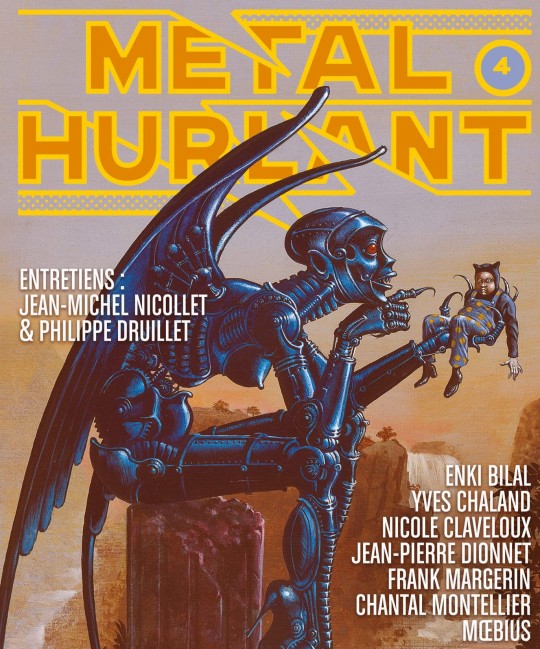
"Métal Hurlant" est toujours considéré comme LE film d'animation à avoir influencé et marqué les esprits à jamais dans le genre de la science-fiction fantaisiste. Bien que certains aspects de son esthétique puissent sembler retro, la qualité de l'animation n'a pas pris une ride, son message et son impact culturel ont résisté à l'épreuve du temps.
Bonne séance.
Le film ICI \m/
7 notes
·
View notes
Text
Pgs. 138-213

Blue John.
Blue John.
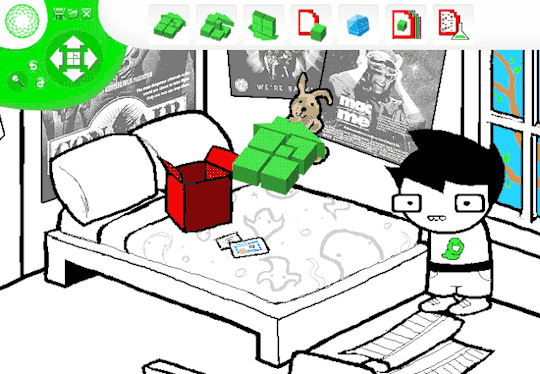
look at him smile. little guy.
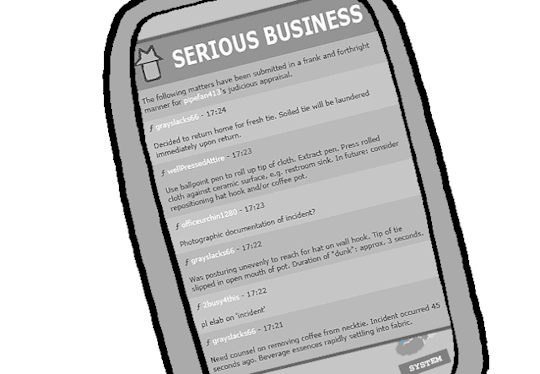
Serious Business is the best social media app, the hub for all businessmen to give advice about their nice attire. however, best guy fedorafreak has not appeared yet.

in which Rose Lalonde exhibits her incredible therapist bullshit, and also a really good line is dropped.
EB: ok, if that will satisfy your weird ocd complex then go ahead.
TT: My Obsessive-Compulsive Disorder complex?
TT: Can a disorder also be a complex?
EB: in your case, probably!

John you fucking FOOLISH BOY you’re going to BLIND YOURSELF.

TT: Whoops.
comedy gold to think about Rose grabbing and ripping a fucking toilet from the pipes only to then consciously type into Pesterchum “whoops” like she’s a fucking cartoon character.

JADE.
HI JADE.

TT: Oh fuck.
again, cartoonish.
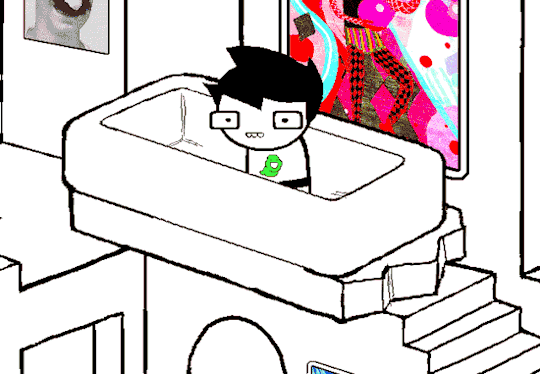

SAY THE LINE, JOHN.
EB: you can see me, right.
EB: tell me what is wrong with this picture.
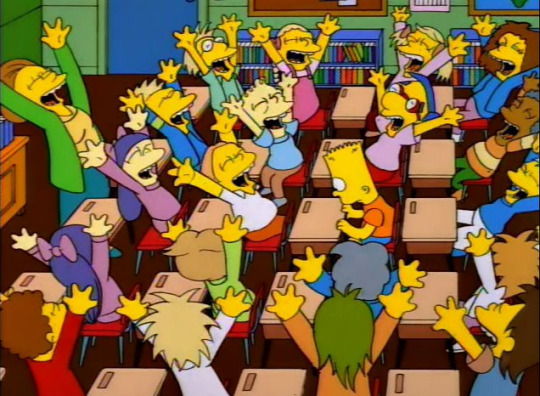
TT: I would look for a stronger signal in another part of the house, but I'd rather not risk an encounter with my mother.
TT: I battled through her cloud of gin and derision once already this evening.
EB: haha, yeah I hear you.
TT: Yes. Cake, jesters, unfaltering love and support.
TT: Quite a road to hoe there.
TT: Though I suppose I'm complicit for not informing Social Services about your situation.
this is the shit I’m talking about when imagining talking about parents with John, Rose is here talking about she can’t stand her alcoholic weirdo housewife mother and John’s just out here like “haha yeah, reminds me of my dad and his cakes.” John someone has a drinking problem and all you can think about is how much you hate clown people.
TT: I've been looking at the GameFAQ walkthroughs to figure some of this stuff out.
it’s very interesting how GameFAQs remains as 1 of the only real world online platforms to ever be reference in the early comic, yet to me, it doesn’t stick out that much. I’m a big fan of how Homestuck utilizes its own programs and sites as close analogs to tools at the time, Pesterchum, Serious Business, the fake browsers and OSes, and so on. these original clients allow for the comic to not drag itself down and let it age horribly by shoving in very specific styles of social sites or apps. at the same time, I can say something like GameFAQs or YouTube being shown on-screen in a casual manner doesn’t take me out of the story because they’re only there to serve their functions and they’re still adding to Homestuck as a period piece. character needs a walkthrough? well everyone at the time would go to GameFAQs for a walkthrough. character wants to share a video? people at the time would use YouTube to share videos. it also helps that GameFAQs is an unchanging monolithic beast that remains the exact same as it was decades ago. not YouTube, I miss the old YouTube designs.
I say this now because later on the comic introduces more direct social media analogues (sometimes even outright naming them), with more attention drawn to the fact that said social media is being parodied, this all ending with said parodies feeling very dated and way too contemporary. I’m looking at you Tumblr, Instagram, Snapchat, fuckin Vine. yeah, remember when Vine was in the comic???

Seizure Ball.

your fate is sealed.
and then the doll gets prototyped with the kernelsprite and...
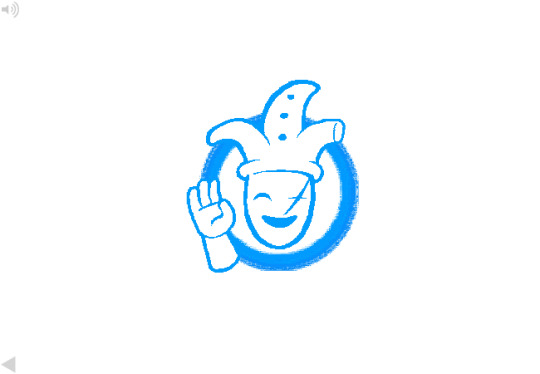
youtube
I LOVE clown music!!!
I don’t know if you can tell by the clownsona in my main blog, or the fact that I literally said this beforehand,
but
I like
jesters.
evil jesters to be specific.
jesters are looked down as fucking fools and little funny idiots, but the moment you make 1 a villain they become terrifying, maddening, and a destructive force of nature.
so of course, I have to say that Homestuck directly appealed to me by introducing a major jester-esque character, as well as having these jester aesthetics permeate throughout the rest of the comic and informing the designs of other characters, mostly villains.
it worked so well I was inspired by pre-Bec Jack Noir’s transformation for this sona.
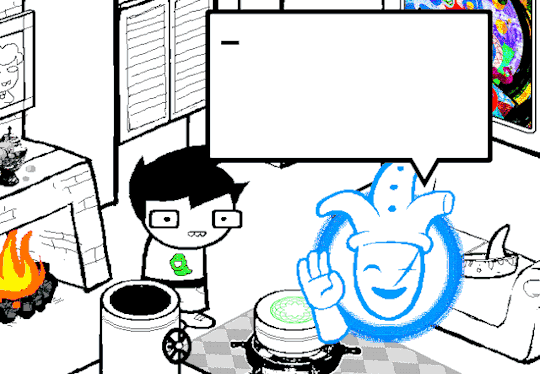
who up speaking in Fleur de Lis.

these are the symbols of Homestuck, not the Slimer shirt, not the Sburb house, none of the fucking trolls, no. these, the perfectly generic objects, green fuck-off cubes that are entirely useless and are canonically the physical representation of jackshit. they are a craft.
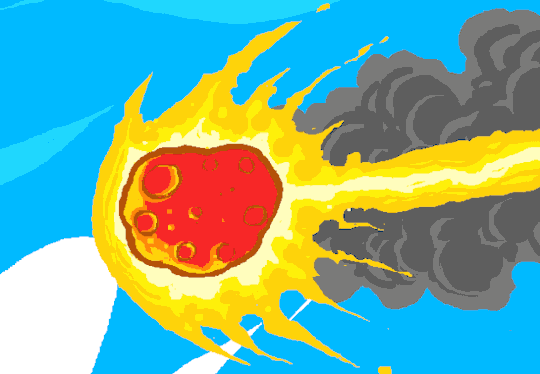
AH SHIT, IT’S A FUCKING THING.
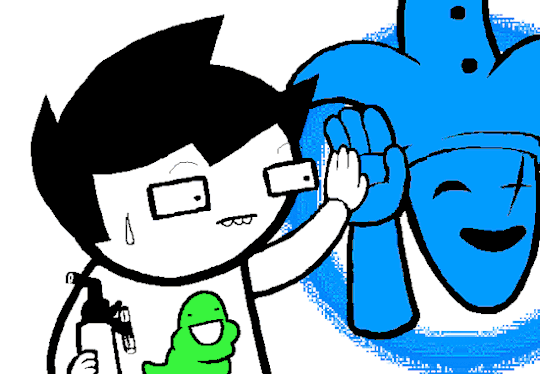
You figure you've left him hanging long enough.
this simple bit that happens within the 1st 200 pages of this comic both introduces a really good running gag but also fucks up an entire late-game, like, end of the fucking comic late-game, writing decision that I still maintain makes no fucking sense and had no reason to exist, especially being randomly introduced at the very end.
but that writing contradiction also spawned Alternate Session which is a really cool fanventure that you should read.

I ate Gushers as a kid, I never had them in years afterwards, but now they’re sold at my college and they’re both tangy candy thingies and fucking disgusting processed trash.
still buy em though.
oh my god it’s this fucking pesterlog oh my god this is it.
TG: like the size of texas
TG: or just rhode island
TG: theyre always throwing around these geographical comparisons to give us a sense of scale like it really means anything to us
TG: but its like it doesnt matter its always just like: WOW THATS PRETTY FUCKING BIG
TG: like mr president theres a meteor coming sir. oh yeah, how big is it? its the size of texas sir
TG: OH SHIT
TG: or, how big is it? its the size of new york city sir
TG: OH SHIT
TG: sir im afraid the comet is the size of your moms dick
TG: OH SNAP
TG: sir are you familiar with jupiter
TG: you mean like the planet?
TG: yeah
TG: well its that big sir
TG: hmm that sounds pretty big
TG: i have a question
TG: is it jupiter?
TG: yes sir, earth is literally under seige by planet fucking jupiter
TG: OH SHIT
Dave, Daaaave. this is my boy. this rambling fucking nonsense is what I think of when I think Dave Strider, it’s so fucking good. planet fucking Jupiter.
and then Rose Lalonde happens.
#homestuck liveblog#hs liveblog#hs reread#liveblog#reread#live read#liveread#homestuck#hs1#hs#home22tuck#Act 1#Flash
10 notes
·
View notes
Photo

Cleanliness may be next to godliness
inasmuch as a man in an immaculate business suit
might, by some random accident, find himself seated
next to a drug addict on the subway, anathema
to civilized society, but undeniably
part of the living fabric
God is not a pharaonic obelisk
remaining motionless in time --
God is Nature, and Nature is a blood hive,
honeycomb dripping with alkaline bile,
queen of serpents, baptized in rabid saliva,
primeval lady of worms, the heathen priestess
veiled in vespertine shades of deepening dusk,
dark hands caked with gold dust and rich black mud,
Bête Noire of the North Star, fixed and rigid,
a vicious bitch running widdershins
around an obstinate monolith
once a day for six days,
seven times on the seventh day,
loudly shouting and sounding the horns
until the walls come tumbling down.
5 notes
·
View notes
Text


My childhood was not happy.
Picture this. It’s 1992. You’re a kid. Your abuser lives a wall away, and your parents chose to protect them instead of you. You’re very much alone. You hate yourself. You wish everything would just end.
And a movie happens. Batman Returns. It’s the only the greatest thing you’ve ever seen. Selina Kyle speaks to your young broken heart in ways you won’t understand until you’re older with therapy. And Batman feels like an unobtainable strength you wish you could sit in the dark shade of forever.
Things don’t get better at home. But you have them at least. You have these movies playing on repeat in your head for three months. Then on September 5th, 1992, Fox Kids premieres a new show. Batman the Animated Series. You don’t know it at the time, but the episode The Cat and the Claw was not the actual start of this madness. But it didn’t matter. There they were. The same feeling the film had, but brighter, deeper, on beautifully painted backdrops and grainy noir color.
And there was Batman. That same monolithic shadow of justice, with a voice that resonated in your bones. But he was different. Not bad different, just…different. Brooding, heavy, and restless—but with a hand of kindness other heroes didn’t seem to have. Adults didn’t seem to have. Something called compassion.
It changes you so entirely. Episode after episode. Show after show. Adventure after adventure. You hated yourself, really and honestly—but this man, who tried so hard to save a city that didn’t love him back—this man who refused to give in to hatred and anger, who would extend a hand to anyone, even a man like the Joker, if it meant saving a life—this man who cared so so much, and lived on a policy of empathy…he made you feel like, no matter how awful a kid you were…Batman would still save you. Batman would still care.
Kevin Conroy is the definitive voice of Bruce Wayne and Batman. To this day, there’s few sounds that bring me the same joy and comfort he could. I always meant to meet him somehow, to tell him what he did for me in my darkest years as an angry, lost, hurting little kid. That this show was one of the only things that made my youth less miserable. That his Dark Knight gave me hope in a hopeless place. But I never got the chance.
Thank you, Kevin Conroy. I know there are more kids out there that were like me, who needed Batman in their lives. You shaped a generation. You changed him forever. You changed me forever.
I love you from far away, and I hold everything you made in the deepest part of me. Batman is my hero. Thank you for giving him to us.
18 notes
·
View notes
Text
Finished Freedom Cry.
As far as American education goes (mind you, the bar isn't just low, it's underground), I received one that didn't give us a rose-tinted version of history. I was taught about Euro-American atrocities, including what Columbus was actually like, the Triangle Trade, and how slavers turned from oppressing Tainos to Africans. My textbook even mentioned Haitian independence (again, bar's underground). But I had to learn about the cultural significance of voudou during the uprising, Code Noir, the backlash from Europe that established the current relationship between Haiti and DR, etc. from other sources, including Freedom Cry.
I like that Ubisoft doesn't flinch away from what Black and Indigenous folks (including the Kanien'kehá:ka in ACIII and Kesegowaase, who is Wolastoqiyik) had to go through during this time period, but instead of painting a pure victim narrative, it reminds us that they had agency, and because people are not monolithic and always clash over the "right" way to help others, there was inner conflict too. And that's not something that's shown in a lot of historical media about slavery, segregation, the Trail of Tears, broken treaties, etc. because they end up taking the white guilt route.
But it's still incredibly difficult to watch. I played that scene on the ship in the final sequence before killing De Fayet, and SPOILERSSTARThaving to leave people still chained up in the ship behind was awful I ran at them several times and tried to find a way around to get to them before realizing there was no way to do soSPOILERSEND.
I still can't believe the audacity of Ubisoft to show these scenes. That includes when Ratohnhaké:ton's village was burned down; Noah Watts mentioned that it was hard to watch with the knowledge that this was the reality Indigenous folks had to face then. I...personally think they should be shown, because that's just reality, but it's difficult to watch.
Speaking of, I'm still salty about having to kill Jing Lang in Black Flag, she was the ONLY Asian around and they did THAT, even though as a group we were not getting oppressed by Europeans or anyone in the Caribbean at the time. If they ever released a game about atrocities against Chinese or Chinese diaspora I'd just turn off the game and leave tbh. Again, should be shown, but difficult to watch.
I love Adéwalé so, so much.
I said I'd probably have a different opinion on what my favorite AC songs are after playing Freedom Cry, but tbh I don't have a particular favorite on this track. It might be my favorite overall track, though.
I had a good chuckle over learning that Tristan D. Lalla was in Raisin in the Sun iykyk.
I'm gonna reboot the sequence where I kill De Fayet again, the first time wasn't satisfying enough brb.
#cw slavery mention#cw genocide mention#ac freedom cry#ac black flag#adewale#assassin's creed#tears falling like peridots#ac#also gonna rethink my recommendation that my caribbean friend play freedom cry#like we talked about it being an interesting experience but it's an emotional toll
6 notes
·
View notes
Text
Esoctrilihum - Astraal Constellations of the Majickal Zodiac (2023)
A 130 minute experimental interstellar black metal epic

With 130 minutes spread over three parts this is a monolithic undertaking, both for the artist and for the listener. However, for those with the fortitude and stamina to complete the journey, you will find top-tier, ground-breaking black metal that tells the gripping tale of of an intergalactic space war between monumental cosmic deities. Each volume presents us with a different mood, combining raw, atmospheric and melodic black metal with synth and piano elements with epic and dramatic results.
#black metal#extreme metal#underground music#cave dweller music#atmospheric black metal#raw black metal#psychedelic metal#progressive metal#Bandcamp
2 notes
·
View notes
Video
youtube
Monolithe Noir - Live At The Freehouse
8 notes
·
View notes
Text
The Joke's On Him

The New York of “Eyes Wide Shut” is a dream of New York—a sex dream about an emotionally and carnally wound-up young man who denies his animal essence, his wife’s, and almost everyone’s. It’s a comedy. Stanley Kubrick’s movies are comedies more often than not—coal-black; a tad goofy even when bloody and cruel; the kind where you aren’t sure if it’s appropriate to laugh, because the situations depicted are horrible and sad, the characters deluded.
To make a film like this work, you need one of two types of lead actors: the kind that is plausible as a brilliant and insightful person who trips on his own arrogance (like Malcolm McDowell’s Alex in “A Clockwork Orange,” Matthew Modine’s Pvt. Joker in “Full Metal Jacket,” and Humbert Humbert in “Lolita”); or the kind that reads as a bit of a dope to start with, and never stops being one. The latter category encompasses most of the human characters in “2001: A Space Odyssey”—first cavemen, then cavemen in spaceships, that legendary bone-to-orbit cut preparing us for the end sequence in which astronaut Dave Bowman evolves while gazing up in awe at the re-appeared monolith—and Ryan O’Neal as the title character of “Barry Lyndon,” a tragedy about a ridiculous and limited man who bleeds and suffers just like everyone, and is moving despite it all.
Tom Cruise’s Dr. Bill Harford in “Eyes Wide Shut” is the second kind of Kubrick hero. He’s is a bit of a dope but takes himself absolutely seriously, never looking inward, at least not as deeply as he should. An undercurrent of film noir runs through most if not all of Kubrick’s films. His first two features, the war fable “Fear and Desire” and the boxing potboiler “Killer’s Kiss,” were stylistically rooted in noir—“Fear and Desire,” like “Paths of Glory” and “Full Metal Jacket,” has terse, hardboiled narration, linking it to the most overtly noir-ish Kubrick film, his breakthrough “The Killing.” The film noir hero tends to be a smart, ambitious, horny guy who lets his horniness overwhelm his judgement. Dr. Bill is a cuckolded film noir patsy turned film noir hero, cheated upon not in fact, but in his own imagination. And, in noir hero fashion, he gets drawn into a sexual/criminal conspiracy, this one involving the procurement of young women for anonymous orgies with rich older men. He’s always one step behind the architects of the plan, whatever it is, and he's never quite smart enough or observant enough to prove he saw what he saw.
That’s Bill, a cinematic cousin of somebody like Fred MacMurray in “Double Indemnity” or William Hurt in “Body Heat,” but diminished and driving himself mad, a eunuch with blueballs, prowling city streets on on the knife-edge of Christmas, constantly taunted and humiliated, his heterosexuality and masculinity, indeed his essential carnality, questioned at every turn.
The doctor’s nighttime odyssey (like “2001,” this film is indebted to Homer) kicks off after he smokes pot with his gorgeous young wife Alice (Nicole Kidman) and she confesses a momentary craving for a sailor so powerful that she briefly considered throwing away her stable life just to have him. The revelation of the intensity of his wife’s sexual craving for someone other than him (fear and desire indeed) unmoors him from his comfortable existence and sends him careening around the city, where he encounters women who all seem to represent aspects of his wife, or his reductive view of her. They even have similar hair color. And if there are men in their lives—like Sidney Pollack’s Victor Ziegler, who calls Bill to deal with a young woman who overdosed on a speedball while in his company; or Rade Serbedjia’s Millich, the pathologically controlling and jealous costume shop proprietor who accuses Bill of wanting to have sex with his teenage daughter (Leelee Sobieski)— They mirror aspects of Bill. It’s surely no coincidence that the masks worn by the orgy participants are distinguished by their prominent (erect) Bills. Bill never actually strays, though. He keeps blundering into situations where sex seems imminent, and yet he couldn’t cheat on Alice even if he wanted to. He’s too bad to be good and too good to be bad.
It still seems amazing that Cruise, among the most controlling of modern stars, gave himself to Kubrick so completely, letting himself be cast in such a sexually fumbling, baseline-schmucky part, the sort Matthew Broderick might've played for more obvious laughs (Kubrick originally wanted Steve Martin as Bill). Cruise built his star image playing handsome, fearless, cocky, ultra-heterosexual young men who mastered whatever skill or job they'd decided to practice, be it piloting fighter jets, driving race cars, playing pool, bartending, practicing law, representing pro athletes, or being a secret agent. Offscreen, the actor was long suspected of being closeted—a rumor amplified by his hyper-controlling relationships with a succession of public-facing spouses who read, from afar, less as wives than wife-symbols—and he sued media outlets that implied he was anything other than a 100% USDA-inspected slab of lady-loving, corn-fed American beefcake (thus the infamous 2006 “South Park” “Tom won’t come out of the closet” scene).
So it was doubly startling for 1999 audiences to watch Cruise being swatted across the screen from one cringe-inducing psychosexual horror setpiece to the next, each enjoying its own version of a hearty pirate’s laugh at the idea of Cruise playing a butch straight man who dominates every room he’s in; and to witness his onscreen humiliation by homophobic frat boys. That same year, Cruise got an Oscar nomination as Best Supporting Actor in “Magnolia,” playing a motivational speaker who admonishes his audience of baying young men to “respect the cock, tame the cunt.”
Cruise is a smart actor with often-excellent taste in material and collaborators; it’s inconcievable that he and his then-wife Kidman would submit themselves to over a year’s worth of grueling, repetitive shoots on Kubrick’s meticulously recreated New York sets in London without understanding what they were in for, at least partially. But what’s really important, from the standpoint of Cruise’s performance, is that he never seems as if he knows that the joke is on Bill. This doesn’t seem like the performance of an actor who has decided not to play his character as self-aware (like, say, Daniel Day-Lewis in “The Last of the Mohicans,” playing a character that Entertainment Weekly’s Owen Gleiberman described as seeming completely free of 20th century neuroses) but rather a not-too-self-aware actor throwing himself into every scene as if bound and determined to somehow “win” them. This is surely a vestigial leftover of the way Cruise acts in most Tom Cruise films, strutting and bobbing through scenes, getting into trouble, then smiling or talking or flying or running or acrobatting his way out. It’s a mode he can’t entirely turn off, but can only tamp down or allow to be subverted (which is what I think is happening in this movie, and in a few other against-the-grain Cruise performances). It’s as if Cruise travels the full narrative length of Kubrick’s dream trail encrusted by scholarly and journalistic and critical footnotes that have accumulated on his filmography since "Risky Business." He’s the leading man as Christmas tree, festooned with lights and baubles.
What perfect casting/what a great performance/what’s the difference? Is there any? Maybe not. Sometimes great casting is what allows for a great performance. John Frankenheimer cast Laurence Harvey, a handsome hunk of wood, as the brainwashed assassin in the 1962 version of “The Manchurian Candidate,” and his inability to tune into his costars’ emotional wavelength works for the part; it translates as “repressed, tortured, closed off individual,” the type of guy who would be gobsmacked by an ordinary summer romance, to the point where it would constitute the core of a tragic backstory. Harvey’s inexpressiveness becomes a source of mirth when he’s put in the same frame with actors like Frank Sinatra, Angela Lansbury, or Akim Tamiroff, who get a predatory glint in their eye when they sense the possibility of stealing a scene. They know how to mess with people and have fun doing it, and poor, friendless Harvey is an irresistible target. and when Raymond expresses delight that he was, however momentarily, “lovable,“ you can practically see the quote marks around the word, and it’s as sad as it is hilarious.
Oliver Stone pulled off something similar when he cast Cruise as Ron Kovic in “Born on the Fourth of July,” a choice that Stone later said might’ve hurt the film at the American box office because nobody wanted to see the smirking flyboy from “Top Gun” castrated by a bullet, wheeling around with a catheter in his hand, cursing his mom and Richard Nixon. The star seeming not-entirely-in on—not the “joke,” exactly, but the vision of the movie—made Kovic’s dawning self-awareness of his participation in macho right-wing propaganda all the more effective. Kovic wanted to be like the guys on the recruiting poster, and now he couldn’t stand up and salute the lies anymore, and a lot of his friends were dead, along with untold numbers of Vietnamese. Al Pacino, who was cast in an aborted version “Born” a decade earlier, might not have been as effective as Cruise overall, because while Pacino is an altogether deeper actor, he’s so closely associated with men who have no illusions about how brutal and soul-draining American life and institutions can be. (Marvelous as his performance in “Serpico” is, it doesn’t start to take off until he’s in undercover cop mode, with that beard and long hair and beatnik/hippie energy. In the early scenes where he’s clean-shaven and idealistic, you just have to take Serpico's innocence on faith, because Al Pacino would never be that naive.)
Kubrick, no slouch at casting for affect, was especially good at filling lead male roles with actors who seemed to grasp the general outline of what the director was up to without radiating profound appreciation of the philosophical and cultural nuances. Ryan O’Neal in “Barry Lyndon” somehow works despite, or because of, seeming a bit stiff and anachronistic—out of his element in a lot of ways. His anxiety-verging-on-panic at not knowing whether he’s doing a good enough job for Kubrick fits perfectly with the character’s persistent insecurity and imposter syndrome. So does the shoddy Irish accent.
Decades later, Ben Affleck in “Gone Girl” pulled an “Eyes Wide Shut”—or maybe it’s more accurate to say that director David Fincher pulled it by casting him. “The baggage he comes with is most useful to this movie,” Fincher told Film Comment. “I was interested in him primarily because I needed someone who understood the stakes of the kind of public scrutiny that Nick is subjected to and the absurdity of trying to resist public opinion. Ben knows that, not conceptually, but by experience. When I first met with him, I said this is about a guy who gets his nuts in a vise in reel one and then the movie continues to tighten that vise for the next eight reels. And he was ready to play. It’s an easy thing for someone to say, 'Yeah, yeah, I’d love to be a part of that,' and then, on a daily basis, to ask: 'Really? Do I have to be that foolish? Do I have to step in it up to my knees?' Actors don’t like to be made the brunt of the joke. They go into acting to avoid that. Unlike comics, who are used to going face first into the ground.”
Fincher subsequently poked fun at Affleck, in DVD narration and interview comments delivered in such a deadpan-vicious way that you couldn't tell if Fincher was venting in the guise of a put-on or doing an elaborate comedic bit. Either way, the gist was that Affleck was convincing as an untrustworthy person because he was himself untrustworthy. "He has to do these things in the foreground where he takes out his phone and looks at it and he puts it away so his sister doesn’t see it," Fincher said. "There are people who do that and it’s too pointed. But Ben is very very subtle, and there’s a kind of indirectness to the way he can do those things. Probably because he’s so duplicitous." Thus does the inherent untrustworthiness of Ben Affleck as both actor and person (according to Fincher, whether he's kidding or serious) become the framework for the entire performance's believability. This is a guy whose performance as an innocent man is judged by the media and public and immediately found lacking, and the character proves to be so much dumber than his conniving, vengeful wife that when the final scene arrives, we laugh at how inevitable it was. A more subtle, likable, deep leading man might've have ruined everything. Fincher needed a meathead who was funny and had read a few books, and who seemed to have a sixth sense for how to hide a cell phone from his sister.
This is similar to the idea of Kubrick cuckolding Cruise with an anecdote and sending him all over New York in search of satisfaction and insight that never quite, er, comes (although there’s a hint of hope in that final scene). On top of that, Affleck is an actor who is effective within a narrow range but will never be thought of as a chameleonic or particularly delicate performer—somebody who can play the subtext without overwhelming the text, or who can seamlessly integrate the two so that you can’t tell where one ends and the other begins.
That might be why Affleck disliked working with Terrence Malick, a highly improvisational filmmaker who deals in archetypes and symbols, and expects actors to devise a character while he’s devising the film that they’re in. Ryan Gosling and Brad Pitt can do that; Affleck really can’t. The difference between Affleck and somebody like Pitt (or DiCaprio) is the difference between an old-fashioned square-jawed leading man-type, like Rock Hudson or Gary Cooper or Alan Ladd, who tried to stick to the words and hit the marks and color within the lines, and somebody like James Dean or Marlon Brando or Dennis Hopper, who treated every page as potential raw material for a collage they hadn’t thought up yet. That’s why Dean and Hudson played off each other so beautifully in “Giant”—Dean with his tormented Method affectations and odd expressions and voices, and Hudson playing the guy he’d been told to play, while often seeming puzzled or horrified by whatever Dean was doing opposite him, as if he’d been placed in the same room with a badger or wild boar and told “Now the two of you sit down and have a nice lunch while we film it.”
I like to think of Cruise in “Eyes Wide Shut” as Rock Hudson turned loose in a Stanley Kubrick neo-noir dream, and not just for the obvious reasons. He’s in there angrily and desperately trying to win something that cannot be won, explain things that can’t be explained, and regain dignity that was lost a long time ago and will never come back. He keeps flashing his doctor’s ID as if he’s a detective (another film noir staple) working a case, and people indulge him not because they truly regard the ID as authority but because Bill’s intensity is just so damned odd that they aren’t sure how else to react. It’s hilarious because Bill doesn’t know how ridiculous it all is, and how ridiculous he is. He’s a movie star who lacks the movie star’s prerogative. Only by surrendering to the flow and accepting defeat can he survive. Only his wife, an awesome force unlocked in one moment, can save him.
-Matt Zoller Seitz
5 notes
·
View notes
Text
EMOTION DECATHLON
Thomas Maël
Lux Aeterna
2001 L'Odyssée de l'espace
Dieu un monolithe noir
Une civilisation un vieux galactique
De quoi faire peur à toutes les sommités psychiatriques
Des mondes hyper-rationnels et technologiques
Ont eu besoin du Terrien
Nature et allégorique scientifique
Dimanche 14 avril 2024
0 notes
Text
L’Univers la Matrice et le Tout
Tes pas félins sur les remparts
Dans tes yeux je vois la pureté de l’eau des montagnes
Je vois l’innocence du nouveau-né
La grandeur des pyramides
L’étourdissement des bacchanales et
Les désirs assoiffés de la Grande Recherche
L’insoupçonnée allégresse lentement tisse sa toile de velours
Autour des nymphes et des chérubins
Et tes joues empourprées te donnent la suavité d’un ange
Tu manges des étoiles
Je te regarde cueillir avec grâce l’immensité des possibles
Ton étreinte…
Si riche
Si poignante
Ténébreuse et hurlante
On dirait un Adieu mais c’est bien un Toujours qu’elle crie
Ton étreinte a le goût d’éternité
Et cette saveur réveille les morts
Je rêve que je t’emmène avec moi
Jusqu’aux confins du désert indévorable
Là où pousse l’amour
T’emmener aux confins du désert pour que tes yeux s’ouvrent en grand
Alors je caresserai ta nuque entre tes cheveux noirs
Et j’embrasserai tendrement ton cou jusqu’à atteindre ton épaule
Désirs cruels comme une odeur de sabotage
Des détours et des songes
Pulsions insensées
Sans tête
Animales comme tes gémissements
Epaule contre épaule
Mes doigts courent sur ta peau d’olympe
Et les sens se réveillent en transe
Rendent muette la raison
Pour sonner au diapason de l’insaisissable
Croquer un bout d’impossible
Enchevêtrements de passions de la première heure
Le soleil vient se noyer rougeoyant dans les larmes de l’océan
Encore faut-il enjamber la mer
Lécher le sel et caresser ta peau frémissante
Au chevet de l’heure dorée
Ta bouche onctueuse et ton abandon aux étoiles
Que faire de tous ces cris
Ces hurlements emprisonnés dans la poitrine et dans le ventre
Comme un fauve
Prêt à bondir
A déchirer les chairs
A l’orée d’une jungle aux méandres impénétrables
Que faire de tous ces cris que seules tes caresses apaisent
Avec tes mains bien faites
Avec tes mains en joie
Dans le silence d’une coursive en colonnades
Bordée de marronniers en fleurs
Roses et blanches
De la mousse sur les marches qui escaladent vers la chapelle
Le grand saut
Un radeau dérivant sur les eaux noires d’encre
S’ancre les balbutiements du grand Inquisiteur
Innocents et purs
Dérive loin de la colère de Dieu
Dérive dans l’ouate des amours dévorés
Jusqu’à atteindre le golfe de la félicité
Bordé d’une extase fière et lourde comme un monolithe d’or
0 notes
